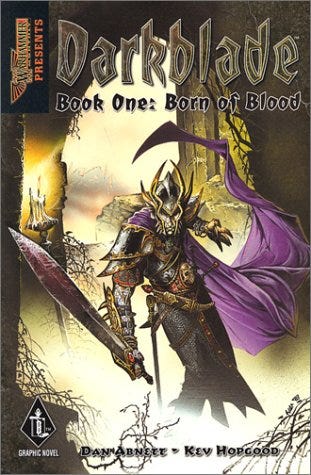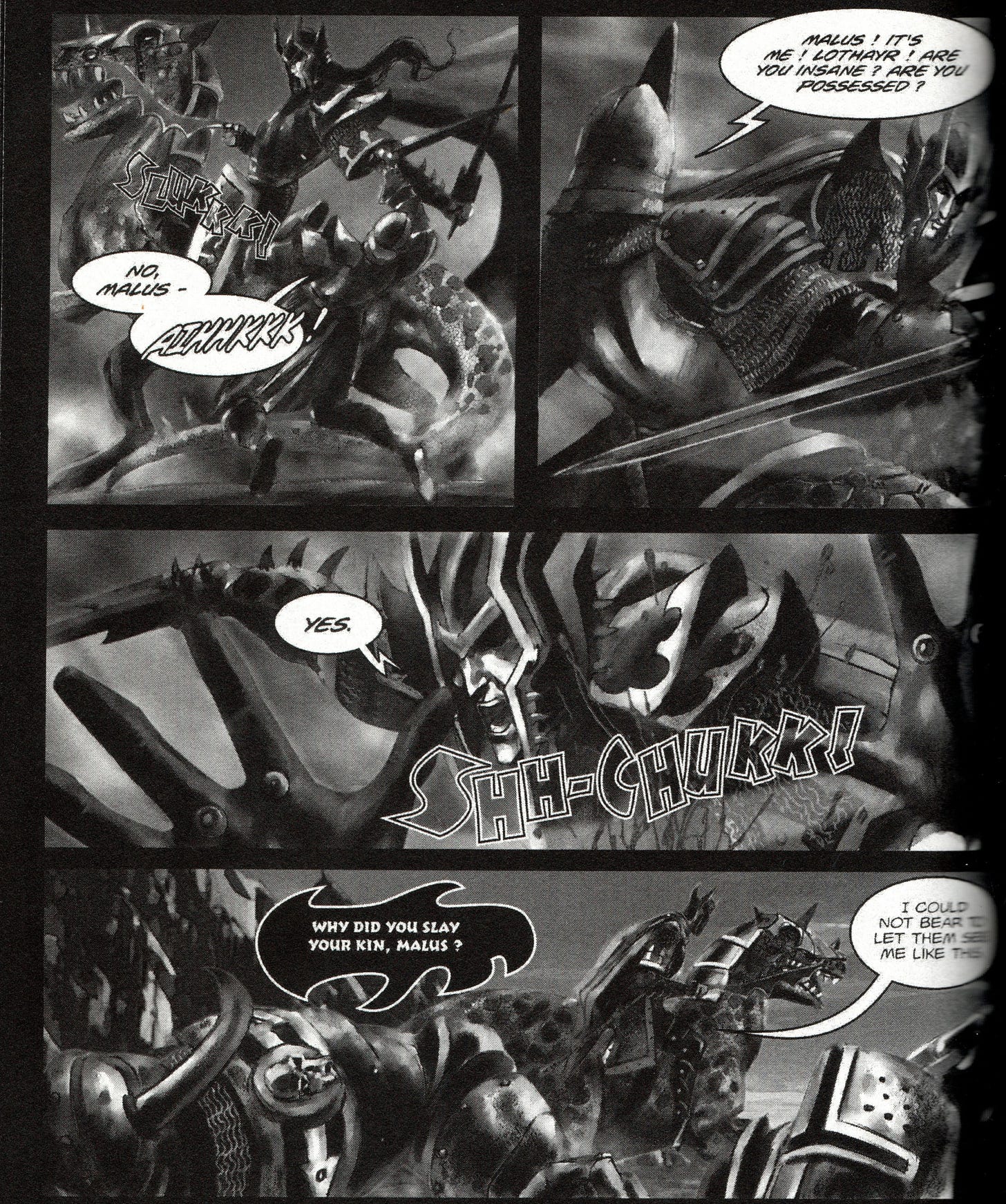Darkblade: Born of Blood - A Warhammer Graphic Novel Review
Discover the comic book origins of Malus Darkblade, Warhammer Fantasy's troubled Elven anti-hero, with this in-depth review of his graphic novel debut.
Darkblade Book One: Born of Blood
Published in 1998
Despite Warhammer’s iconic, larger-than-life imagery, its few adventures into the world of comics have been surprisingly brief and ill-fated. The sole exception is Malus Darkblade, the conniving Dark Elf warlord possessed by the daemon Tz’arkan and doomed to hunt down the artifacts needed to sever the unwanted union. Created by Warhammer fiction powerhouse and prolific comic writer Dan Abnett, Malus would go on to claim four graphic novels, a couple of one-shots, a six-novel series, and a miniature in Warhammer Fantasy Battle.
When it comes to prominent Old World characters, only Gotrek and Felix are more recognizable. That’s no easy feat and more than enough to make Malus Darkblade the uncontested king of Warhammer comics.
His comic debut in 1998, simply titled Darkblade, was published across six parts in Warhammer Monthly, finishing at a modest 64 pages. The graphic novel covers the same material as the prose novels, though it’s a far shorter version of his quest. Many of the character’s more unique elements, specifically his dangerous parentage and slightly more humanizing qualities, hadn’t been developed yet.
The clever moments and wit are still present but otherwise, he feels more like a “standard” example of an ambitious Dark Elf. More importantly, there’s not as much to differentiate Malus from his obvious inspiration, Elric of Melniboné — though he’s even more mercenary and self-serving than Moorcock’s foundational dark fantasy anti-hero.
That’s also how Darkblade stood out and established itself as a classic Warhammer Fantasy tale – some of the novels’ excesses aren’t present but this comic fully commits to a villainous protagonist. Warhammer’s heroes tend to be dark but Abnett draws from the franchise’s creative debts to 2000 AD, home of Judge Dredd and many other satirical anti-heroes.
Between Malus’ quest across Chaos-infused wastelands and the short length, we don’t see much of him as a footsoldier for the Dark Elves’ empire of piratical torturers. But Abnett still establishes that he isn’t a secretly principled outlier like Dungeons & Dragons’ Drizzt. Malus Darkblade is “Druchii” to his bones, to the point that Tz’arkan is appalled by his treacherous actions. Almost all of the dialogue in Darkblade is focused on Malus’ bickering dynamic with the daemon, who may have met his match when it comes to pettiness and cruelty.
Another consequence of the comic’s length is how moments that would be reframed as tragic or horrific in the novels are much more bombastic or darkly humorous here. Immediately after Malus’ possession, he willingly butchers his followers. Even Tz’arkan is taken aback, prompting Malus to reveal he simply couldn’t bear for them to see him in such a wretched state.
In Darkblade, these are just faceless minions dispatched to set up Malus and Tz’arkan’s old-married-couple-like squabbling. By contrast, the novels would later reframe this as the shocking betrayal of established and loyal followers, without changing much of the circumstances or dialogue.
As one would expect from all that, the comic has a straightforward story. Each part shows Malus trying to outsmart the mysteries and monsters guarding each artifact. It’s simple, straightforward fun — a corrupt, ignoble version of Hercules’ labors.
With such a lean story, Darkblade owes quite a bit to Kev Hopgood’s strong art. His work hews closely to the tabletop designs, even the more dated and goofy ones, but he brings a good level of detail and the right instincts for an action-heavy, pulpy adventure. Hopgood’s depiction of Malus’ physical transformation as he succumbs to Tz’arkan’s possession is particularly memorable.
It’s a good shorthand for what makes the story work: seeing Malus go through increasingly degrading and elaborate trials. The over-the-top villainy of a Dark Elf protagonist has limited charm, but Abnett and Hopgood instead focus on Malus and Tz’arkan’s increasing exhaustion with their plight. They’re quite literally a match made in hell, and seeing them fight provides most of the comic relief and drama.
But the increasingly inventive solutions to each challenge are the main draw, especially since one of the pair, if not both, pay the price for Malus’ quick thinking.
If I have one complaint about Darkblade, it’s the awkward digital effects and gaudy 90s CG that was sadly common in Warhammer Monthly. It ages Hopgood’s black-and-white art in a very avoidable way. Fortunately, the writing and visuals are competent enough that the weaker parts are a distraction at most. Thankfully the final chapter avoids that problem entirely, as Malus and Tz’arkan get what they want and what they deserve. It’s a satisfying conclusion that sets up future installments without feeling like a cliffhanger ending.
While not the most ambitious Warhammer story, Darkblade built a strong foundation that’s still fun to revisit, a story that commits to the over-the-top villainy that’s always made Warhammer stand out from the crowd.
The first Darkblade comic collection was never released digitally. Darkblade Volume 1: Born of Blood can be found for around 20 USD, with the more comprehensive collected editions occasionally showing up at that price but usually costing more.








